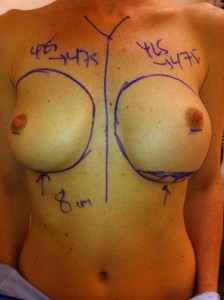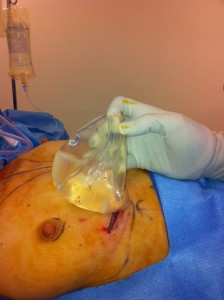Capsular Contracture Leading to a Ruptured Saline Implant
Posted On: April 07, 2012 Author: The Office of Dr. Stuart Linder Posted In: Breast Implants, Breast Revision, Ruptured Implant
 The above patient presents with severe scar tissue contracture, Baker IV capsular contracture leading to a ruptured saline implant. The patient had severe bottoming out of the right implant with implants placed by a different surgeon at a different part of the country. In any case, she is noted as having severe bottoming out with encapsulation of the upper pole of the right breast causing the implant to become inferiorly displaced. The right implant through a severe Baker IV capsular contracture over eight years led to hardening around the bag and severe encapsulation leading to a ruptured saline implant with a valvular leak.
The above patient presents with severe scar tissue contracture, Baker IV capsular contracture leading to a ruptured saline implant. The patient had severe bottoming out of the right implant with implants placed by a different surgeon at a different part of the country. In any case, she is noted as having severe bottoming out with encapsulation of the upper pole of the right breast causing the implant to become inferiorly displaced. The right implant through a severe Baker IV capsular contracture over eight years led to hardening around the bag and severe encapsulation leading to a ruptured saline implant with a valvular leak.
 The preoperative photo shows a significant deflation of the right breast with complete loss of upper pole fullness and flattening of the entire chest. Clinical diagnosis of saline implant shows the ruptured implant. No diagnostic testing is necessary for this saline rupture. The implant is then removed under general anesthesia and after prepping and draping the patient. Notice the yellow color of the fluid in the bag which is consistent with a chronic rupture. This patient will undergo bilateral open periprosthetic capsulectomy, removal of bilateral implants, circumferential capsulotomies and reconstruction with high profile saline implants in order to regain upper pole fullness as well as an inframammary tightening procedure in order to remove skin along the left inframammary fold to reduce the distance from the 6 o’clock position of the nipple areolar complex to the inframammary fold to match bilaterally with 8 cm even.
The preoperative photo shows a significant deflation of the right breast with complete loss of upper pole fullness and flattening of the entire chest. Clinical diagnosis of saline implant shows the ruptured implant. No diagnostic testing is necessary for this saline rupture. The implant is then removed under general anesthesia and after prepping and draping the patient. Notice the yellow color of the fluid in the bag which is consistent with a chronic rupture. This patient will undergo bilateral open periprosthetic capsulectomy, removal of bilateral implants, circumferential capsulotomies and reconstruction with high profile saline implants in order to regain upper pole fullness as well as an inframammary tightening procedure in order to remove skin along the left inframammary fold to reduce the distance from the 6 o’clock position of the nipple areolar complex to the inframammary fold to match bilaterally with 8 cm even.
Ruptured silicone implants appear in my office on a weekly basis from patients throughout the United States. These should be removed and replaced as soon as possible in order to reduce the encapsulation and scar tissue impingement of the pocket.